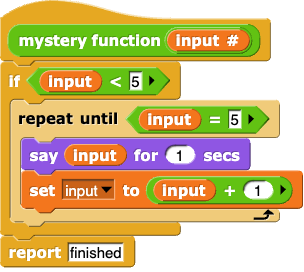
set command sets the value of the variable k to the value k – m, not m – k.
a ← 3 b ← a a ← 4 DISPLAY(b)
b ← ais done).
b ← ais done); b doesn't remember that the 3 came from a so it doesn't change when a is changed.

set command sets the value of the variable k to the value k – m, not m – k.
 Which inputs to
Which inputs to mystery function will report "finished"?
repeat until loop will stop, and the function will report "finished."
report command isn't inside the if.
repeat until block checks the value of input every time through the loop, not just its initial value.
 What will the sprite say if you run the same function with the input 1?
What will the sprite say if you run the same function with the input 1?


repeat until work?

repeat until block runs the code in its script slot until input = 5, then the computer skips down to the next command, report (finished), without the sprite ever saying 5.

repeat until block tests the value of input before running the code in its script slot.
 What will happen if you run the same function with the input 9?
What will happen if you run the same function with the input 9?
if block do when input is 9?
set instruction do to the value of input?
if command run?
if command will not run.




Imagine you make a variable capitals and use set to give this list of lists a name:

Which of the following statements are true?
Choose all that apply.
 reports a list with two items: "Augusta" and "Maine".
reports a list with two items: "Augusta" and "Maine".
 reports the word "Augusta".
reports the word "Augusta".
 reports the word "Iowa".
reports the word "Iowa".
 reports the number 8.
reports the number 8.
 reports a list with one item: "Iowa".
reports a list with one item: "Iowa".
 reports the string "Boise".
reports the string "Boise".
 reports the string "Iowa".
reports the string "Iowa".
all but first of (capitals) are lists.
 reports the number 2.
reports the number 2.
Which of the scripts below will produce the following sprite behavior?

(When you run the script, though, it actually says Abraham Lincoln only once.)
Choose all that apply.
![for each (item) of {Abraham, Lincoln} [say (item) for (1) secs] for each (item) of {Abraham, Lincoln} [say (item) for (1) secs]](/bjc-r/img/3-lists/check1abec1.png)



inputList ← [3, -1, 2, 10, -5]
FOR EACH item IN inputList
{
IF(item > 0 AND item * item > 4)
{
DISPLAY(item)
}
}
IFinstruction test? What does the
DISPLAYinstruction in this code display?
DISPLAYinstruction in this code display?
PROCEDURE Mystery(numberList, targetNumber)
{
counter ← 0
FOR EACH number IN numberList
{
IF(number > targetNumber)
{
counter ← counter + 1
}
}
RETURN(counter)
}
myMathGrades ← [100, 80, 90, 80, 60, 100, 50, 100]
Mystery(myMathGrades, 60)
 ?
?


true if num is less than or equal to 23.


numberis odd:
IF (MISSING CONDITION)
{
DISPLAY "It is odd."
}number MOD 1 = 0
MODreturns the remainder when the first input is divided by the second. Whether a number is odd or even depends on divisibility by 2.
number MOD 1 = 1
MODreturns the remainder when the first input is divided by the second. Whether a number is odd or even depends on divisibility by 2.
number MOD 2 = 0
number MOD 2returns the remainder when
numberis divided by 2. If that remainder is zero, is the number odd or even?
number MOD 2 = 1
number MOD 2returns the remainder when
numberis divided by 2. If
number MOD 2is 1, then the number is odd.
 ?
?
Mod gives you the remainder, not the quotient.
When will "Error. Invalid entry." be displayed?
PROCEDURE greaterThanOrEqualTo(a, b)
IF(a > b)
{
RETURN(true)
}
ELSE
{
RETURN(a = b)
}
DISPLAY("Error. Invalid entry.")
}
a > bis true.
RETURNdoes. Like
report in Snap!, RETURNends the procedure. Once it is run, no other code in that procedure is run, and the flow of control returns to the place where the procedure was called.
a > bis false.
RETURNdoes. Like
report in Snap!, RETURNends the procedure. Once it is run, no other code in that procedure is run, and the flow of control returns to the place where the procedure was called.
RETURNdoes. Like
report in Snap!, RETURNends the procedure. Once it is run, no other code in that procedure is run, and the flow of control returns to the place where the procedure was called.